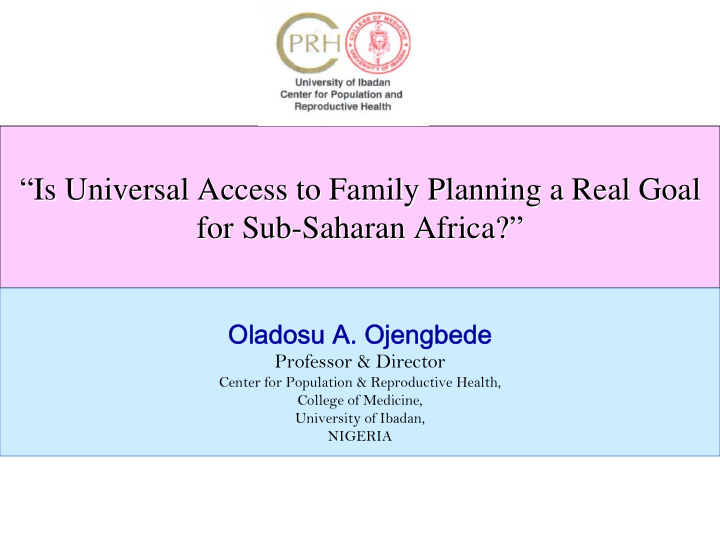



“Is Universal Access to Family Planning a Real Goal Is Universal Access to Family Planning a Real Goal “ for Sub- -Saharan Africa? Saharan Africa?” ” for Sub Oladosu A. Ojengbede Professor & Director Center for Population & Reproductive Health, College of Medicine, University of Ibadan, NIGERIA
The Bane of SSA Poor Maternal Health Indices Insensitivity to the population explosion by all o The socio-cultural and religious interpretation o of marital bliss o Quantity vs. Quality The flaring effect of the triage of poverty, o ignorance and disease
Low contraceptive uptake is another reality in SSA. P Prata 2009: Making FP accessible in resource poor settings. Phil Trans Soc B, 364:3093 ‐ 3099
The Ripple Effects of Years of Neglect Failure of sustainable o developments and targets at all fronts Fracture of key sectors o that impact on human developments
Higher Fertility Projection in Nigeria: Primary School Students Fewer Students, More Resources per Child Number of Students (Millions) High Fertility Low Fertility 6 Source: The Futures Group, Spectrum Projections, 2010
There is Poor Commitment to Women’s Health in SSA. Sub-Saharan Africa (SSA) has the highest level of maternal mortality of any world region with 640 deaths per 100,000 live births (WHO, 2010). McTavish et al 2010. National female literacy, individual socio- economic status and maternal health in SSA. Soc Sc Med 71:1958- 1963
High unmet need for Family Planning in SSA is the root cause of the poor maternal health indices. Huge disparity in access to FP and other RH services between the rich and the poor
Birth spacing in northern Nigeria: The gist of strategic transformation of traditional rulers as advocates
Percent distribution of women with short birth intervals (7-23 months) by state, DHS Nigeria 2008 Sokoto Katsina Yobe Jigawa Zamfara Kebbi Borno Kano Gombe Bauchi Kaduna Niger Adamawa Plateau Kwara Federal Capital Territory Nassarawa Oyo Taraba Ekiti Kogi Osun Benue Ondo Ogun Lagos Edo Enugu Anambra Ebonyi Cross River ² Imo Delta Abia Women with birth interval Akwa Ibom 31.7% - 40.7% Bayelsa Rivers 25.2% - 31.6% 18.8% - 25.1% 0 0.5 1 2 Miles 11.2% - 18.7%
The secrets of our interactions with the Emirs � Using hard facts � NDHS &FMOH data on MCH and FP � Translational research evidence � Making them discover they are key players for FP awareness, promotion and uptake � Educating them that family health leads to family wealth � Household is the primary producer of health � Letting them navigate towards solutions that fit their settings � Birth spacing instead of family planning
How to Improve FP uptake in SSA � Macro-level strategies � Generate and sustain momentum for Government commitments in the sub-region (ECOWAS -> African Union) – Shiffman & Okonofua BJOG 2007 � Legislate to support women’s autonomy to decide on FP use as part of a comprehensive package of RH care Konje & Ladipo IJGO 1999; Cleland et al., 2006 � Implement policies to improve quality counseling and access to delay childbearing � Family Life Education Program/Sexuality Education
How to Improve FP uptake in SSA-2 � Micro-Level strategies � Break through barriers of socio-cultural inhibitions through strategic communication channels (IEC) � Integrate FP services into all RH programs including PMTCT � Re-invigorate immediate post-partum contraception programs to avert challenges of default � Accelerate female empowerment programs � Actively engage males in FP access and uptake
Missed Opportunities: Insights from the 2008 NDHS Of the women who were not using family planning in the 12 months preceding the survey: • 4% were visited by a health provider who discussed family planning. • 13% visited a health facility but did not discuss family planning. of women neither discussed family planning 92% with a fieldworker nor with staff at a health facility.
We must also identify our Allies and form a United Coalition to fight for and promote FP access to all in SSA Agencies Faith Schools Communities Strong Communities Community Elected Leaders Officials Business Parents People 15
Can we take advantage of our peculiarities? � Improve access to IEC and uptake through non-orthodox methods Use of police and other security check points to o distribute IEC and some FP methods Enlist retired health professionals within their o community as advocates for FP � We need evidence
Conclusions � FP acceptability must be through a multi- prongged approach that should be colored with � Socio-cultural sensitivity � Solid evidence � Sustainability � Surely, FP success in SSA is a panacea to the region’s sustainable development
A POSER: WILL THE SITUATION OF THIS LITTLE GIRL BE ANY DIFFERENT A POSER: FROM HER MUM’S?
Recommend
More recommend